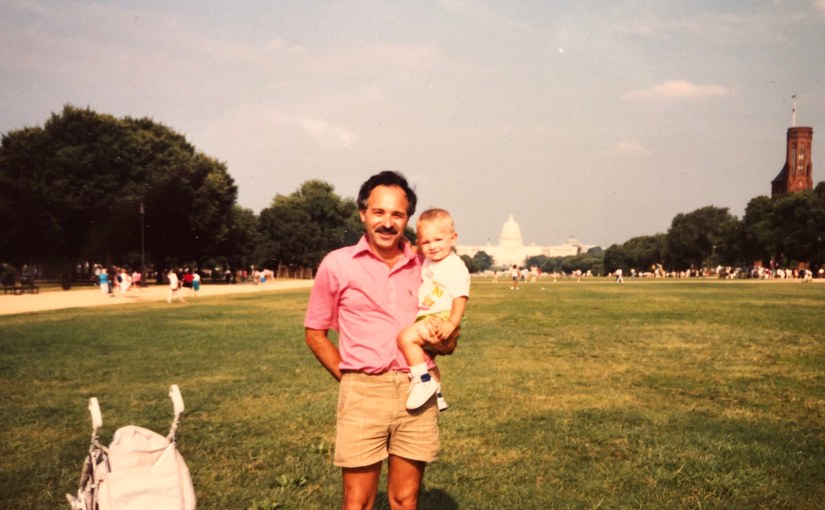Recent research of my family history has yielded a story of survival that has given me a new appreciation for my heritage. My paternal grandmother Betty Pritzker was from the last of 5+ generations of Jews, mostly Orthodox rabbis, to hail from the once thriving Ukrainian shtetl (Yiddish for “little town”) of Golovanevsk three hours south of Kyiv.

As shown on this petition for U.S. citizenship, on October 5, 1914 her mother (my great-grandmother) Yetta Talansky married my great-grandfather Rabbi Samuel Pritzker from nearby Berdychiv. Also shown are my grandmother Betty (Basia in Yiddish), aunts Clara (Chaika) and Pearl (Perel). The Pritzker family emigrated to America in 1925 to escape anti-Jewish pogroms being committed across Ukraine in the aftermath of World War I.

More than 800 pogroms were committed in the territories of the Russian Empire between 1917-1920, claiming the lives of 50,000-100,000 Jews.[1] In Ukraine alone in 1919, 30,500 Jews were murdered in pogroms.[2] This violence was born out of the decline of the Central Powers in World War I. While occupying Ukraine at the end of the war, desperate German forces attempted to incite Ukrainian nationalism by installing a “social nationalist” puppet government which envisioned a strong national identity. Their version of Ukraine recalled a heroic past and nationalist future without Jews as part of the national state.[3]
In the power vacuum that followed, civil wars broke out between Ukrainian nationalists, Red and White Army Russians, and anarchists. In the region of Ukraine my great-grandmother and grandfather lived, White Russian Army forces loyal to the tsar targeted Jews as pro-Bolshevik and promoted antisemitic rumors to rile up citizens. A British war correspondent visiting White Army headquarters in Ukraine at the time observed: “The officers and the men of the army laid practically all the blame for their country’s trouble on the Hebrew.”[4] The people of my family’s hometown of Golovanevsk organized a self-defense militia unit after an incident on December 18, 1917, in which the Jewish stands of the town marketplace were looted and nine pogromists and civilians were killed in the ethnic violence that followed.[5]
Though the self-defense unit helped prevent further violence in this incident, it wasn’t as lucky in August 1919 when it was defeated by White Army forces under Lt. Gen. Yakov Slashchov. On August 4, 1919 Slashchov’s men killed 200 Jews in Golovanevsk as retaliation for the militia’s armed opposition.[6] In January 1920 my grandmother Betty was born, but the residence of Golovanevsk must have finally become untenable for the Pritzkers after another deadly pogrom less than a month later. This New York Tribune article from February 25, 1920 describes anti-Jewish massacres committed by Lt. Gen. Anton Denikin’s White Army forces, including “more than fifty victims…counted at Golovanesk” (sic).

The Pritzkers emigrated from “Golowanewsk, Russia” August 13, 1925, departing from Hamburg, Germany on the S.S. Ohio according to this U.S. Department of Labor passenger list. After a pit stop in Pittsburgh where the Hebrew Immigrant Aid Society assisted with resettlement, the family permanently settled in New York City, then home to more than 1.6 million Jews.

The 1930 and 1940 U.S. Censuses give clues to their early immigrant lives in Brooklyn, New York. In the 1930 U.S. Census Samuel Pritzker is still listed as “Rabbi,” combining faith and commerce as the industry listed next to occupation is “chicken market” in 1930 and “poultry wholesale” in 1940. My great-grandmother Yetta is listed as a “Housemaker,” grandmother Betty as a “floor girl” in a “watch factory,” and the family of five all Yiddish speakers. The total household income for their 1940 Brownsville, Brooklyn house was $3,898 (roughly $75,650 today).
Below: author’s photo of Rabbi Samuel Pritzker’s headstone in Golowanesker section of Baron Hirsch Cemetery, Staten Island, NY, with Hebrew translation

My great-grandfather Rabbi Samuel Pritzker passed away from a blood clot in his heart on Christmas day 1940. From August 1941-January 1944 the Jewish population of his birthplace of Berdychiv, once the city with the highest density Jewish population in the Russian Empire[7] (78%), was exterminated in a series of executions committed by Waffen-SS forces during Nazi occupation, claiming 17,000 lives.[8] Four years after that in 1948, my father became the first Pritzker in our immediate family born in America. We never got a chance to thank his grandfather for giving us that opportunity.

Works Cited
Aly, G. (2017). Europe Against the Jews 1880-1945. New York: Picador.
Buryak, C. (2020). History of the Jewish Communities in Ukraine. Retrieved from http://jewua.org/golovanevsk/
Klinov, Y. (1921). A Chapter of Self-Defense: Trying to Reach an Understanding with the Ukrainians – The Pogrom of 18 December 1917. Retrieved from https://www.jewishgen.org/yizkor/Golovanevsk/gol157.html
Kobalia, A. (2018). Between the “Whites” and the “Reds”: Who carried out pogroms against the Jews during the Civil War? Ukrainian Jewish Encounter. Retrieved from https://ukrainianjewishencounter.org/en/between-the-whites-and-the-reds-who-carried-out-pogroms-against-the-jews-during-the-civil-war/
Yad Vashem: The World Holocaust Remembrance Center, Golovanevsk. (2021). Retrieved from https://www.yadvashem.org/untoldstories/database/index.asp?cid=883
Yahad in Unum: Berdychiv. (2021). Retrieved from https://yahadmap.org/#village/berdychiv-zhytomir-ukraine.12
Endnotes
[1] Kobalia, 2018
[2] Aly, 2017, p. 117
[3] Aly, 2017, p. 115-116
[4] Aly, 2017, p. 133
[5] Klinov, 1921, p. 157
[6] Yad Vashem, 2021; Buryak, 2020
[7] Aly, 2017, p. 45
[8] Yahad in Unum: Berdychiv, 2021

